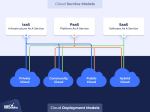“Chip-to-Cloud IoT looks like a promising way to .build a more secure, useful and decentralized technology for all.”
Shannon Flynn
Most Internet of Things (IoT) products are not secure by design. In fact, they’re a primary reason for the recent explosion in cybercrime. One report showed 2.9 billion cyber incidents in the first half of 2019. The researchers specifically called out the proliferation of the IoT along with Windows Server Message Block (SMB), as a leading cause. Decentralized technology through chip-to-cloud IoT may be the answer to these problems.
IoT introduces almost countless opportunities for improvement at the consumer and commercial technology levels. Personal uses include smart homes and smart cars. IoT provides overwatch across numerous cyber-physical systems in industrial settings and facilitates data mobility like never before.
Rampant Cybersecurity concerns surrounding IoT are leading some technologists to call for a different kind of architecture. Chip-to-cloud IoT looks like a promising way to build a more secure, useful, and decentralized technology for all.
Current Security Challenges With IoT Devices
IoT devices are everywhere right now transforming our homes, offices, and entire cities into smart environments. We’ve been seeing an increasing demand for IoT devices for years now, and there’s no slowing down to it.
Soon, every device will be connected, and it is going to be quite a spectacular time for all of us. To achieve this, the devices need to be truly smart, and most importantly, secure. Any company producing or using smart devices has to make security its top priority because IoT devices have become a favorite target for hackers. You’ve probably heard of their numerous exploits on the news.
The hackers have already proven their ability to breach the security systems of IoT devices creating concerning and even life-threatening situations. For instance, we’ve already seen hackers spying on people in their homes using smart devices, which made heads turn towards the problem of IoT security.
The other problem here is the increasing number of IoT edge nodes or end-user devices generating and collecting immense amounts of data. IoT edge nodes like laptops, smartphones, or industrial robots used by the employees allow for a safer and more controlled working environment, but these devices might be vulnerable to cyber-attacks.
Considering how the IoT edge nodes are connected to the data centers, skilled hackers can access your data centers by laying their hands on any of your edge devices. That is exactly why chip-to-cloud security is the next big thing in the IoT domain and why smart device manufacturers are willing to invest billions in this technology.
What is Chip-to-Cloud
Two years ago Alibaba announced its plans to invest over $28 billion in Cloud infrastructure to address the growing demand for business software during the pandemic. Connected devices have become vital to rapidly transforming enterprises, whether on-site or off-site, and the deployment of cloud-based enterprise computing plays a significant part in the development of connectivity technologies. Of course, the benefits of the well-designed connectivity between the devices can be nullified by the cyber-threats. You cannot have profit before you have security.
So, what is Chip-to-Cloud security, and how will it change the IoT in the nearest future? Well, if you are trying to manufacture a secure and reliable smart device, the first thing you need to take care of is a trusty hardware – the chipset. A goal here is to select hardware that does not only comply with its intended use specifications but also offers solid security characteristics.
The chip must provide a set of advanced security features like a cryptography accelerator, a hardware random number generator, and reliable RAM, just to name a few. Naturally, when it comes to IoT devices or any devices connected to the Internet for that matter, trusted software architecture is a must-have. It prevents hackers from spoofing your identity or cloning your device for any malicious purpose.
At this point, a secure connection to the Cloud becomes paramount, and you need to provision your devices with the right credentials, adhere to the cloud service enrollment guidelines, and make sure the security processes are not being compromised.
With that out of the way, the next step is proper device monitoring and management. You must be able to monitor the health and behavior of your devices as well as detect any attempts at tampering with their integrity.
Basically, Chip-to-Cloud is a technology that enables creating secure-by-design devices using energy efficient microchips that stay connected to the cloud at all times.
With the rapid growth in the number of connected devices, engineers must be sure they are completely secure. Industries and even entire economies rely on the security of IoT devices, which is exactly why chip-to-cloud technology is the next big thing in that domain.
Features Of Chip-to-Cloud IoT
Onboard security and computational power are two of the most significant shortcomings of IoT devices. In addition to being more powerful and safe than previous models, IoT devices built with chip-to-cloud security are also more energy-efficient.
Here are the features that make the Chip-to-Cloud technology so effective:
- An onboard cryptography engine
- Generator of random numbers
- Sufficient random-access memory (RAM)
How Chip-to-Cloud Works
Reliable software design is essential for IoT devices and other internet-connected devices. It keeps hackers from stealing your identification or duplicating your device for their ulterior motives. Chip-to-Cloud delivers on all fronts.
These chipset characteristics confer an extra security advantage. Each IoT node is cryptographically unique, making it nearly impossible for a hacker to impersonate it and access the more extensive corporate network to which it is connected. Chip-to-Cloud speeds things up by eliminating the need for traffic delays between the logic program and the edge nodes that are ready to take action on the information.
The Chip-to-Cloud architecture of the internet-of-things is secure by design. New tools are being developed to provide bespoke and older equipment with data mobility capabilities, just like the current IoT.
Nevertheless, Chip-to-Cloud chipsets are always connected to the cloud. As a result, the availability of assets and the speed of digital communication across nodes, departments and facilities will be significantly improved. Chip-to-Cloud IoT is a significant step forward in the evolution of the IoT toward Web3. Experts predict IoT device customers and value producers will benefit more from these design principles than centralized providers.
What’s Next
What we all need to understand is that the profit-before-security approach will not work here. Leaving our smart devices exposed to attacks is not an option, and that is exactly why so many tech giants worldwide invest billions into secure-by-design devices. The early adopters will gain a huge edge over the competitors. Providing the users with full ownership of device security is the main goal here, and the companies with the deepest pockets have already made their steps in that direction.
Tech giants like Microsoft and Amazon have been working on Chip-to-Cloud solutions for quite some time, making the security of the hardware and safeguarding the users from the most meticulous attacks a top priority. Developing processor-based security solutions is crucial for staying vigilant against the cyber-threats, and here at Intersog, we too explore the potential of bringing the security to the chip level and enhancing the security capabilities of the hardware via the means of Chip-to-Cloud technology.
The safety of IoT devices is essential to the operation of many businesses—and even entire economies. Engineers are under increasing pressure to ensure that the rapidly expanding number of interconnected devices is safe. This is why Chip-to-Cloud technology is poised to become the next big thing in this field.
Final Thoughts
With billions of smart devices connected to each other, the vulnerability of the entire ecosystem might produce disastrous consequences, and simply acknowledging this fact is not enough. The chip-to-cloud technology might just prove to be the right solution that can provide smart device producers with a chance to guarantee safety to their users.
Chip-to-Cloud IoT is a significant step forward in the evolution of the IoT toward Web3. Experts predict IoT device customers and value producers will benefit more from these design principles than centralized providers.
🅐🅚🅖
Interested in Management, Design or Technology Consulting, contact anil.kg.26@gmail.com
Get updates and news on our social channels!
LATEST POSTS
- A Tale Of Two Frameworks: Spring Boot vs. Django
 “Spring Boot’s convention over configuration approach simplifies development, allowing developers to focus on building robust applications rather than wrestling with… Read more: A Tale Of Two Frameworks: Spring Boot vs. Django
“Spring Boot’s convention over configuration approach simplifies development, allowing developers to focus on building robust applications rather than wrestling with… Read more: A Tale Of Two Frameworks: Spring Boot vs. Django - Unleashing The Power Of Django
 “Django, akin to a Swiss Army knife, provides a comprehensive toolkit, facilitating developers in tackling diverse web development challenges with… Read more: Unleashing The Power Of Django
“Django, akin to a Swiss Army knife, provides a comprehensive toolkit, facilitating developers in tackling diverse web development challenges with… Read more: Unleashing The Power Of Django - Potential of Progressive Web Apps (PWAs)
 “PWAs are not just about technology; they are about creating meaningful connections with users.” Why PWAs Are the Next Frontier… Read more: Potential of Progressive Web Apps (PWAs)
“PWAs are not just about technology; they are about creating meaningful connections with users.” Why PWAs Are the Next Frontier… Read more: Potential of Progressive Web Apps (PWAs) - Unleashing The Power Of Spring Framework
 “Spring Framework simplifies enterprise Java development, but it does so in a way that embraces existing frameworks and infrastructure.” –… Read more: Unleashing The Power Of Spring Framework
“Spring Framework simplifies enterprise Java development, but it does so in a way that embraces existing frameworks and infrastructure.” –… Read more: Unleashing The Power Of Spring Framework - Key Trends Of OSINT In 2024
 “The future of OSINT lies in our ability to adapt and innovate. By embracing emerging technologies and ethical best practices,… Read more: Key Trends Of OSINT In 2024
“The future of OSINT lies in our ability to adapt and innovate. By embracing emerging technologies and ethical best practices,… Read more: Key Trends Of OSINT In 2024 - Can Google’s Carbon Language Replace C++?
 “While Carbon may excel in performance-critical domains, it cannot replace the versatility and extensive ecosystem of C++.” As the world… Read more: Can Google’s Carbon Language Replace C++?
“While Carbon may excel in performance-critical domains, it cannot replace the versatility and extensive ecosystem of C++.” As the world… Read more: Can Google’s Carbon Language Replace C++? - Integration of Design Thinking, Lean, and Agile
 “Innovation thrives when Design Thinking, Lean, and Agile converge, creating a powerful force that propels organizations towards excellence.” In today’s… Read more: Integration of Design Thinking, Lean, and Agile
“Innovation thrives when Design Thinking, Lean, and Agile converge, creating a powerful force that propels organizations towards excellence.” In today’s… Read more: Integration of Design Thinking, Lean, and Agile - Benefits Of Infrastructure as Code (IaC)
 “Infrastructure as Code is the single most important thing you can do to improve the agility, reliability, and security of… Read more: Benefits Of Infrastructure as Code (IaC)
“Infrastructure as Code is the single most important thing you can do to improve the agility, reliability, and security of… Read more: Benefits Of Infrastructure as Code (IaC) - Power Of Internet of Everything (IoE)
 “The true power of the Intebrnet of Everything lies not in the things themselves, but in the connections and insights… Read more: Power Of Internet of Everything (IoE)
“The true power of the Intebrnet of Everything lies not in the things themselves, but in the connections and insights… Read more: Power Of Internet of Everything (IoE) - How Is The Enterprise IoT Evolving?
 “IoT is not just about connecting things; it’s about connecting minds, creating experiences, and transforming industries.” Pavan Singh, IoT Mentor… Read more: How Is The Enterprise IoT Evolving?
“IoT is not just about connecting things; it’s about connecting minds, creating experiences, and transforming industries.” Pavan Singh, IoT Mentor… Read more: How Is The Enterprise IoT Evolving? - IT Pricing Strategy And Models
 “The art of pricing lies in finding the perfect balance between capturing value and satisfying customers.” In the ever-evolving landscape… Read more: IT Pricing Strategy And Models
“The art of pricing lies in finding the perfect balance between capturing value and satisfying customers.” In the ever-evolving landscape… Read more: IT Pricing Strategy And Models - What Is SYCL (“sickle”)?
 “SYCL provides a powerful and intuitive programming model that simplifies heterogeneous computing, allowing developers to write portable code that can… Read more: What Is SYCL (“sickle”)?
“SYCL provides a powerful and intuitive programming model that simplifies heterogeneous computing, allowing developers to write portable code that can… Read more: What Is SYCL (“sickle”)? - What Is A Data Lakehouse?
 “With a data lakehouse, organizations can break down data silos, democratize data access, and accelerate innovation by enabling data exploration… Read more: What Is A Data Lakehouse?
“With a data lakehouse, organizations can break down data silos, democratize data access, and accelerate innovation by enabling data exploration… Read more: What Is A Data Lakehouse? - 5G – The Future Of The Internet
 “5G is the next big step in the evolution of wireless technology. It will offer significantly faster speeds and lower… Read more: 5G – The Future Of The Internet
“5G is the next big step in the evolution of wireless technology. It will offer significantly faster speeds and lower… Read more: 5G – The Future Of The Internet - Ransomware Groups Are Switching To Rust
 “Rust is to Ransomware what a lockpick is to a thief – a powerful tool that can be used for… Read more: Ransomware Groups Are Switching To Rust
“Rust is to Ransomware what a lockpick is to a thief – a powerful tool that can be used for… Read more: Ransomware Groups Are Switching To Rust - Streaming Data Pipelines
 “A streaming data pipeline is like a river: it flows continuously, changes constantly, and requires monitoring to ensure it stays… Read more: Streaming Data Pipelines
“A streaming data pipeline is like a river: it flows continuously, changes constantly, and requires monitoring to ensure it stays… Read more: Streaming Data Pipelines - Why Rust Is Best?
 “Rust is a systems programming language that runs blazingly fast, prevents segfaults, and guarantees thread safety.” Rust is a modern… Read more: Why Rust Is Best?
“Rust is a systems programming language that runs blazingly fast, prevents segfaults, and guarantees thread safety.” Rust is a modern… Read more: Why Rust Is Best? - Database Sharding Explained
 “Database sharding is like breaking a large puzzle into smaller, more manageable pieces, enabling improved scalability, performance, and availability, but… Read more: Database Sharding Explained
“Database sharding is like breaking a large puzzle into smaller, more manageable pieces, enabling improved scalability, performance, and availability, but… Read more: Database Sharding Explained - Ambient Computing Will Be The Future Tech
 “Ambient computing creates a seamless technology-rich environment, but challenges in privacy, security, ethics, interoperability, user acceptance, and technical complexity must… Read more: Ambient Computing Will Be The Future Tech
“Ambient computing creates a seamless technology-rich environment, but challenges in privacy, security, ethics, interoperability, user acceptance, and technical complexity must… Read more: Ambient Computing Will Be The Future Tech - Key Trends Of OSINT In 2023
 “OSINT is not just a technique, it’s a mindset. It’s about looking at the world with an open mind and… Read more: Key Trends Of OSINT In 2023
“OSINT is not just a technique, it’s a mindset. It’s about looking at the world with an open mind and… Read more: Key Trends Of OSINT In 2023 - Why Is OSINT Important?
 “OSINT is not just a technique, it’s a mindset. It’s about looking at the world with an open mind and… Read more: Why Is OSINT Important?
“OSINT is not just a technique, it’s a mindset. It’s about looking at the world with an open mind and… Read more: Why Is OSINT Important? - DataOps Explained
 “DataOps is the practice of integrating data engineering and data analytics to enable agile development, testing, and deployment of data-driven… Read more: DataOps Explained
“DataOps is the practice of integrating data engineering and data analytics to enable agile development, testing, and deployment of data-driven… Read more: DataOps Explained - Transformation Platform as a Service (tPaaS)
 “tPaaS is all about enabling Digital Transformation by providing a platform that supports fast, agile and secure development and deployment… Read more: Transformation Platform as a Service (tPaaS)
“tPaaS is all about enabling Digital Transformation by providing a platform that supports fast, agile and secure development and deployment… Read more: Transformation Platform as a Service (tPaaS) - Hello Julia – Programming Language For Scientific Computing
 “Julia is a high-level, high-performance dynamic programming language designed for numerical computing, data science, and scientific computing.” The Julia Language… Read more: Hello Julia – Programming Language For Scientific Computing
“Julia is a high-level, high-performance dynamic programming language designed for numerical computing, data science, and scientific computing.” The Julia Language… Read more: Hello Julia – Programming Language For Scientific Computing - Top Programming Languages For Fintech
 “The top programming languages for Fintech are those that provide robust and secure frameworks for handling sensitive financial data, as… Read more: Top Programming Languages For Fintech
“The top programming languages for Fintech are those that provide robust and secure frameworks for handling sensitive financial data, as… Read more: Top Programming Languages For Fintech - How To Choose A NoSQL Database
 “SQL databases are like Excel spreadsheets. They’re good for storing structured data that you need to query in a specific… Read more: How To Choose A NoSQL Database
“SQL databases are like Excel spreadsheets. They’re good for storing structured data that you need to query in a specific… Read more: How To Choose A NoSQL Database - Zero Knowledge Proof Explained
 “Zero Knowledge Proof is a powerful cryptographic tool that enables secure and private communication without revealing sensitive information, making it… Read more: Zero Knowledge Proof Explained
“Zero Knowledge Proof is a powerful cryptographic tool that enables secure and private communication without revealing sensitive information, making it… Read more: Zero Knowledge Proof Explained - Embracing Decentralized CyberSecurity
 “Decentralized CyberSecurity moves responsibilities and controls away from the center, to the individual areas most vulnerable to attack today.” Security… Read more: Embracing Decentralized CyberSecurity
“Decentralized CyberSecurity moves responsibilities and controls away from the center, to the individual areas most vulnerable to attack today.” Security… Read more: Embracing Decentralized CyberSecurity - Global Impact of Ransomware Attacks
 “The global impact of ransomware attacks is a sobering reminder that cybersecurity is not just about protecting our data and… Read more: Global Impact of Ransomware Attacks
“The global impact of ransomware attacks is a sobering reminder that cybersecurity is not just about protecting our data and… Read more: Global Impact of Ransomware Attacks - Process Orchestrator Explained
 “Process orchestrator is the ultimate tool for achieving operational excellence, enabling you to optimize processes, improve productivity, and reduce costs.”… Read more: Process Orchestrator Explained
“Process orchestrator is the ultimate tool for achieving operational excellence, enabling you to optimize processes, improve productivity, and reduce costs.”… Read more: Process Orchestrator Explained - What Does Platform Engineering Do?
 “The success of a Digital Platform depends on the strength of its underlying engineering. Solid engineering principles ensure reliability, scalability,… Read more: What Does Platform Engineering Do?
“The success of a Digital Platform depends on the strength of its underlying engineering. Solid engineering principles ensure reliability, scalability,… Read more: What Does Platform Engineering Do? - Are Full-Stack Developers Obsolete?
 “According to the Stack Overflow 2016 Developer Survey, Full-Stack Developers are one of the highest-paid and most sought-after professionals today.”… Read more: Are Full-Stack Developers Obsolete?
“According to the Stack Overflow 2016 Developer Survey, Full-Stack Developers are one of the highest-paid and most sought-after professionals today.”… Read more: Are Full-Stack Developers Obsolete? - Top 5 Issues For Overusing Microservices
 “Microservices should only be seriously considered after evaluating the alternative paths.” The overuse of new architectural styles is common within… Read more: Top 5 Issues For Overusing Microservices
“Microservices should only be seriously considered after evaluating the alternative paths.” The overuse of new architectural styles is common within… Read more: Top 5 Issues For Overusing Microservices - Customer Experience (CX) Trends In 2023
 “Customer Experience is the next competitive battleground. It’s where business is going to be won or lost.” Tom Knighton, Executive… Read more: Customer Experience (CX) Trends In 2023
“Customer Experience is the next competitive battleground. It’s where business is going to be won or lost.” Tom Knighton, Executive… Read more: Customer Experience (CX) Trends In 2023 - Cognitive Computing In 2023 And Beyond
 “IBM defines Cognitive Computing as systems that learn at scale, reason with purpose and interact with humans naturally.” 2022 was… Read more: Cognitive Computing In 2023 And Beyond
“IBM defines Cognitive Computing as systems that learn at scale, reason with purpose and interact with humans naturally.” 2022 was… Read more: Cognitive Computing In 2023 And Beyond - Top 7 Digital Transformation Trends In 2023
 “The threat of a recession coupled with the ongoing need for transformation and growth means CIOs must make force multiplying… Read more: Top 7 Digital Transformation Trends In 2023
“The threat of a recession coupled with the ongoing need for transformation and growth means CIOs must make force multiplying… Read more: Top 7 Digital Transformation Trends In 2023 - Top 5 DevOps Trends in 2023
 “The Global DevOps market size is expected to expand at a CAGR of 24.59% by 2027, reaching over 22199.4 million… Read more: Top 5 DevOps Trends in 2023
“The Global DevOps market size is expected to expand at a CAGR of 24.59% by 2027, reaching over 22199.4 million… Read more: Top 5 DevOps Trends in 2023 - Top 5 Cybersecurity Predictions For 2023
 “Cybersecurity will continue to be a major focus for company leaders as they bolster their digital defenses in 2023 and… Read more: Top 5 Cybersecurity Predictions For 2023
“Cybersecurity will continue to be a major focus for company leaders as they bolster their digital defenses in 2023 and… Read more: Top 5 Cybersecurity Predictions For 2023 - Top 5 Cloud Computing Trends In 2023
 “Cloud Computing has been one of the most critical technologies of the last decade.” The ongoing mass adoption of Cloud… Read more: Top 5 Cloud Computing Trends In 2023
“Cloud Computing has been one of the most critical technologies of the last decade.” The ongoing mass adoption of Cloud… Read more: Top 5 Cloud Computing Trends In 2023 - 10 Technology Trends For 2023
 What are the best new technologies to learn to improve your career and knowledge? Technology today is evolving at a… Read more: 10 Technology Trends For 2023
What are the best new technologies to learn to improve your career and knowledge? Technology today is evolving at a… Read more: 10 Technology Trends For 2023 - Top 5 AI /ML Trends In 2023
 “AI continues to transform our world as companies look to win over consumers with intelligent experiences delivered in real time… Read more: Top 5 AI /ML Trends In 2023
“AI continues to transform our world as companies look to win over consumers with intelligent experiences delivered in real time… Read more: Top 5 AI /ML Trends In 2023 - Android Runs Better When Covered In Rust
 “C/C++ should no longer be used to start new projects and that Rust should be deployed where a language without… Read more: Android Runs Better When Covered In Rust
“C/C++ should no longer be used to start new projects and that Rust should be deployed where a language without… Read more: Android Runs Better When Covered In Rust - Cybersecurity Mesh Architecture (CSMA)
 “CSMA is geared toward simplifying security architecture by encouraging collaboration and integration of a corporate security architecture.” One of the… Read more: Cybersecurity Mesh Architecture (CSMA)
“CSMA is geared toward simplifying security architecture by encouraging collaboration and integration of a corporate security architecture.” One of the… Read more: Cybersecurity Mesh Architecture (CSMA) - Data Mesh And It’s Principles
 “Data Mesh is a strategic approach to modern data management and a way to strengthen an organization’s digital transformation journey,… Read more: Data Mesh And It’s Principles
“Data Mesh is a strategic approach to modern data management and a way to strengthen an organization’s digital transformation journey,… Read more: Data Mesh And It’s Principles - Hard Tech To Disrupt The Future
 “Affordable robotics, AI-driven sensor fusion, uninterrupted connectivity and supermaterials are merging into the technology stack to unlock massive new tranches… Read more: Hard Tech To Disrupt The Future
“Affordable robotics, AI-driven sensor fusion, uninterrupted connectivity and supermaterials are merging into the technology stack to unlock massive new tranches… Read more: Hard Tech To Disrupt The Future - Top 5 Cloud Computing Vulnerabilities
 “Protecting your organization requires accepting the fact that your systems will be breached at some point; therefore, your strategy should… Read more: Top 5 Cloud Computing Vulnerabilities
“Protecting your organization requires accepting the fact that your systems will be breached at some point; therefore, your strategy should… Read more: Top 5 Cloud Computing Vulnerabilities - What’s Next After Cloud Computing – Edge?
 “Now, some companies are looking to replace Cloud Computing with something called Sky, Edge, or Hybrid Computing.” In the past few… Read more: What’s Next After Cloud Computing – Edge?
“Now, some companies are looking to replace Cloud Computing with something called Sky, Edge, or Hybrid Computing.” In the past few… Read more: What’s Next After Cloud Computing – Edge? - Chip To Cloud IoT
 “Chip-to-Cloud IoT looks like a promising way to .build a more secure, useful and decentralized technology for all.” Shannon Flynn… Read more: Chip To Cloud IoT
“Chip-to-Cloud IoT looks like a promising way to .build a more secure, useful and decentralized technology for all.” Shannon Flynn… Read more: Chip To Cloud IoT - How To Secure The Cloud
 “Encryption, Configuration are one of the best ways to secure your Cloud Computing systems.’ Fortunately, there is a lot that you… Read more: How To Secure The Cloud
“Encryption, Configuration are one of the best ways to secure your Cloud Computing systems.’ Fortunately, there is a lot that you… Read more: How To Secure The Cloud - Top 7 Advanced Cloud Security Challenges
 “Before jumping feet-first into the Cloud, understand the new and continuing top Cloud Security challenges your organization is likely to… Read more: Top 7 Advanced Cloud Security Challenges
“Before jumping feet-first into the Cloud, understand the new and continuing top Cloud Security challenges your organization is likely to… Read more: Top 7 Advanced Cloud Security Challenges - Why Cloud Security Is Important
 “Cloud Security is the whole bundle of technology, protocols, and best practices that protect Cloud Computing environments, applications running in… Read more: Why Cloud Security Is Important
“Cloud Security is the whole bundle of technology, protocols, and best practices that protect Cloud Computing environments, applications running in… Read more: Why Cloud Security Is Important - Why Implement Zero Trust Security Model?
 “Zero Trust extends the principle of ‘least privilege’ to its ultimate conclusion: Trust no one and grant the least privilege,… Read more: Why Implement Zero Trust Security Model?
“Zero Trust extends the principle of ‘least privilege’ to its ultimate conclusion: Trust no one and grant the least privilege,… Read more: Why Implement Zero Trust Security Model? - Advantages And Disadvantages Of Cloud Computing
 “When weighing the Cloud Computing advantages and disadvantages, it’s important to keep the sources of those pros and cons in… Read more: Advantages And Disadvantages Of Cloud Computing
“When weighing the Cloud Computing advantages and disadvantages, it’s important to keep the sources of those pros and cons in… Read more: Advantages And Disadvantages Of Cloud Computing - Benefits Of Cloud Computing
 “Cloud Computing benefits organizations in many ways. In fact, the benefits are so numerous that it makes it almost impossible not… Read more: Benefits Of Cloud Computing
“Cloud Computing benefits organizations in many ways. In fact, the benefits are so numerous that it makes it almost impossible not… Read more: Benefits Of Cloud Computing - Why WebAssembly Is The Future Of Computing?
 “WebAssembly is a binary instruction format and virtual machine that brings near-native performance to web browser applications, and allows developers… Read more: Why WebAssembly Is The Future Of Computing?
“WebAssembly is a binary instruction format and virtual machine that brings near-native performance to web browser applications, and allows developers… Read more: Why WebAssembly Is The Future Of Computing? - Virtualization In Cloud Computing
 “Virtualization and Cloud Computing are often discussed interchangeably, but while they’re closely associated, these tech terms have crucial differences.” Virtualization… Read more: Virtualization In Cloud Computing
“Virtualization and Cloud Computing are often discussed interchangeably, but while they’re closely associated, these tech terms have crucial differences.” Virtualization… Read more: Virtualization In Cloud Computing - Cloud Service And Deployment Models
 “I don’t need a hard disk in my computer if I can get to the server faster… carrying around these… Read more: Cloud Service And Deployment Models
“I don’t need a hard disk in my computer if I can get to the server faster… carrying around these… Read more: Cloud Service And Deployment Models - Why Use Serverless Computing
 “Serverless Computing is a Cloud computing execution model that lets software developers build and run applications and servers without having… Read more: Why Use Serverless Computing
“Serverless Computing is a Cloud computing execution model that lets software developers build and run applications and servers without having… Read more: Why Use Serverless Computing - Spatial Computing Revolutionizing Our World
 “Today, new technologies are advancing at dizzying speeds –impacting all areas of our lives, including how we shop and pay… Read more: Spatial Computing Revolutionizing Our World
“Today, new technologies are advancing at dizzying speeds –impacting all areas of our lives, including how we shop and pay… Read more: Spatial Computing Revolutionizing Our World - Trending Fullstack Frameworks
 “Writing the first 90 percent of a computer program takes 90 percent of the time. The remaining ten percent also… Read more: Trending Fullstack Frameworks
“Writing the first 90 percent of a computer program takes 90 percent of the time. The remaining ten percent also… Read more: Trending Fullstack Frameworks - Threat Intelligence Explained
 “Threat intelligence is evidence-based knowledge about an existing or emerging menace or hazard to assets that can be used to… Read more: Threat Intelligence Explained
“Threat intelligence is evidence-based knowledge about an existing or emerging menace or hazard to assets that can be used to… Read more: Threat Intelligence Explained - Docker’s Role In Microservices
 “Docker is an open platform for developing, shipping, and running applications. Docker enables you to separate your applications from your… Read more: Docker’s Role In Microservices
“Docker is an open platform for developing, shipping, and running applications. Docker enables you to separate your applications from your… Read more: Docker’s Role In Microservices - Why Is Kafka The First Choice For Microservices?
 “Kafka is an event streaming platform used for reading and writing data that makes it easy to connect Microservices.’ When… Read more: Why Is Kafka The First Choice For Microservices?
“Kafka is an event streaming platform used for reading and writing data that makes it easy to connect Microservices.’ When… Read more: Why Is Kafka The First Choice For Microservices? - Pros And Cons Of Microservices Architecture
 “Microservices Architecture has become increasingly popular in recent years. It offers a number of advantages over traditional monolithic architectures, but… Read more: Pros And Cons Of Microservices Architecture
“Microservices Architecture has become increasingly popular in recent years. It offers a number of advantages over traditional monolithic architectures, but… Read more: Pros And Cons Of Microservices Architecture

